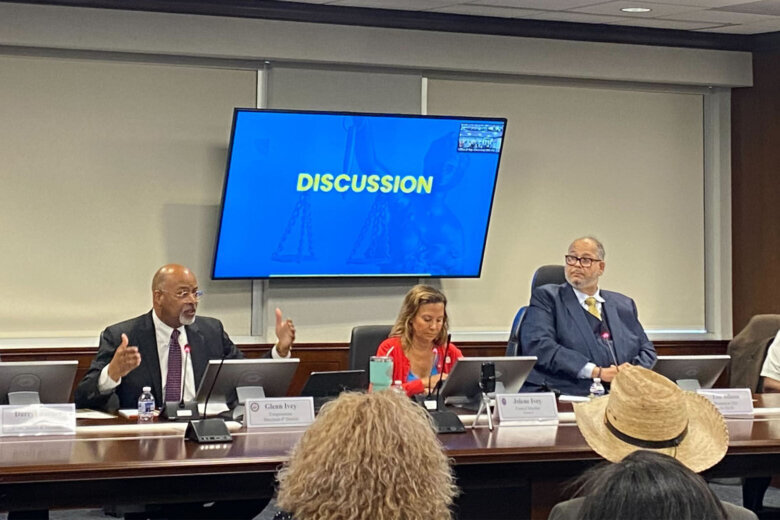
A proposal is moving through the Prince George’s County Council that would limit residential building permits in 2024 — and more severely in areas beyond the Beltway and designated transit areas.
The resolution is being sponsored by Council Chair Thomas Dernoga and is backed by four other members of the Council. If approved, it would cap the number of new building permits that could be issued in 2024 at 2,800 dwelling units total. But 2,100 of them would have to be inside the Beltway, or within a mile of Interstates 95 and 495.
Dernoga said it’s about promoting “smart growth,” as the county’s Plan 2035 — passed in 2014 — intended.
“Even though that’s the policy, it has not been implemented,” Dernoga said. “Actually, we’ve been sprawling all over the place, which has put us behind in road construction — we’ve got road congestion all over the county. We’ve got fire stations we don’t have money to build, we have schools we don’t have money to build.”
He said his idea is similar to one that’s been used in Howard County for decades. But the building industry is raising alarms about this concept.
“That priority area that he’s mentioning, it is very challenging to build there,” said Lori Graf, who heads the Maryland Building Industry Association. “That’s the reason the numbers are somewhat low. Because we can’t build there. It’s very challenging. There’s a lot of added expenses.”
She said the county can do more to make it easier to build in those parts of the county, whether it’s reducing the amount of red tape that has to be cut in order to start building or reducing impact fees in those areas the way Montgomery County has.
“It’s a great idea to encourage development and more housing inside the Beltway,” said Casey Anderson, a former chair of the planning board in Montgomery County who now consults for Rodgers Consulting. He’s also working with the MBIA. “The way to do that is to make it easier and more attractive to develop inside the Beltway, not try to make it harder and more expensive to develop outside the Beltway.”
Dernoga downplayed the concerns about the impact of capping development inside the Beltway at 2,100, saying it’s a number that hasn’t been met in more than a decade, “so it’s not really a cap.”
“And the other thing is, as part of the negotiations, we could literally have no cap,” Dernoga said. “The proposal has a generous cap. If people don’t feel that generous cap is generous enough, or creates other concerns about whether there’d be enough units, we can talk about not having a cap inside the Beltway.”
But he said development away from transit centers has overwhelmed the county, despite efforts to encourage builders to target those areas. And he said the new infrastructure and amenities needed, from schools to police and fire services, end up costing more than the tax revenue generated.
Anderson said the county is just reaching a point where those suburban developments are beginning to pay off, claiming a project that a builder in his firm is working on in the southern part of the county is calculated to generate a net gain of over $1,000 per resident when it’s completed.
Stephen Fuller, a professor at George Mason University who is well-known for studying the region’s economy, also criticized the idea.
“Prince George’s County has been experiencing net domestic out-migration focused largest (but not exclusively) on persons age 25-34 and 35-44 years old. These are precisely the ages of workers that the county requires to support a growing economy,” Fuller wrote in an email to WTOP.
Fuller added that “residents are leaving the county in larger numbers than they are moving to the county” largely due to quality-of-life issues: “Housing is the number one variable in that equation.”
He said focusing inside the Beltway and around transit hubs isn’t wrong, but it’s also not the only answer.
“Not all housing communities in the suburbs generate the negative effects associated with sprawl,” Fuller wrote.
It’s a matter of locating housing in the suburbs, and housing convenient to retail and other services, according to Fuller.
Dernoga countered that argument by saying, “If you’ve had 30, 40, 50 years of development, sprawling out and not going into the places that you have targeted, at some point you need to put a cap on the places that you don’t want growth. Let it occur, but at a slower speed and then focus the development where you want it to go.”
Graf said the proposal would hurt the county in another way, too.
“Homebuilding provides a lot of jobs,” Graf said. But, she warned, if the resolution passes “there will be a lot of uncertainty in Prince George’s County. There will be a lot less houses built, regardless of where they’re building, and that will affect people’s jobs. A lot of people live in Prince George’s County that work in the homebuilding industry.”
While the legislation has five sponsors total, it will need six votes to take effect. It’s not clear when the measure will be taken up by a Council committee.









